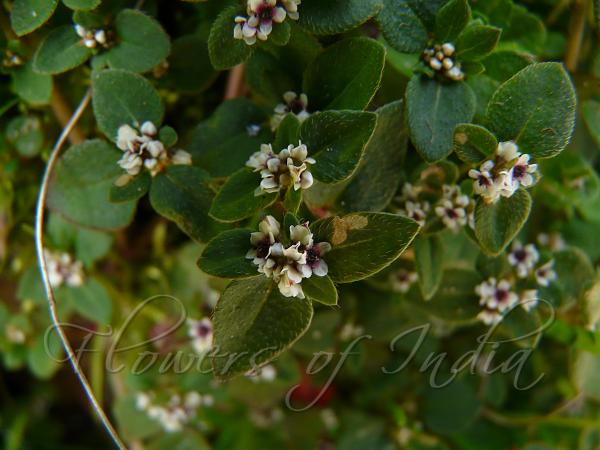|
| Nepal Purslane |
|

|

| File size | 2454135 |
| Original date | 6/10/10 10:56 AM |
| Resolution | 2560 x 1920 |
| Flash | Flash did not fire, auto |
| Focal length | 4.6mm |
| Exposure time | 1/60s |
| Aperture | 2.8 |
| Focus Distance | |
| Metering Mode | Multi-segment |
| Camera make | Panasonic |
| Camera model | DMC-FZ18 |
| Sensor type | OneChipColorArea |
|
|
|
|
Photo: |
Botanical name: Koenigia nepalensis Family: Polygonaceae (Knotweed family)
Synonyms: Polygonum filicaule, Persicaria minuta
Synonyms: Polygonum filicaule, Persicaria minuta
Nepal Purslane is an annual, prostrate or spreading 10-30 cm branched
herb. Stem is flaccid, bearing sparse, yellowish, deflexed, appressed
hairs. Leaves are ovate to lanceshaped, distant, 4-10 x 3-5 mm, pointed,
entire, rounded at the base, with horizontal hairs on both the surfaces.
Ochrea is thick, cup-shaped, membranous, sometimes 2-3-partite, hairy, 2-3
mm long. Flowers are borne in flat topped corymbs at branch ends, with 5-6
flowers in each corymb. Flower-stalks are 1-1.5 mm long, jointed. Flower
tube is 5-partite, divided, almost up to the base, white or pink, outer 2
smaller, obovate-ovate, sometimes spathulate, usually obtuse, 1.75-2 x
1-1.5 mm. Stamens are 3, filaments very short, staminodes 5, alternating
and larger than the stamens. Styles are 3, short, free, stigma rounded. Nepal Purslane is a plant of higher altitudes, grows in moist places and
under rocks with mosses between 3000-5000 m. Usually it is overlooked by
the collectors. It is found in the Himalayas, from Pakistan, Kashmir to
Bhutan, Xizang and China. Flowering: June-September.
| Identification credit: Krishan Lal | Photographed in Tawang District, Arunachal Pradesh. |
• Is this flower misidentified? If yes,